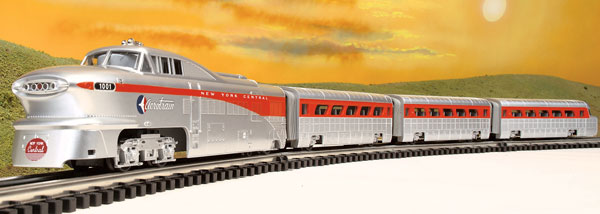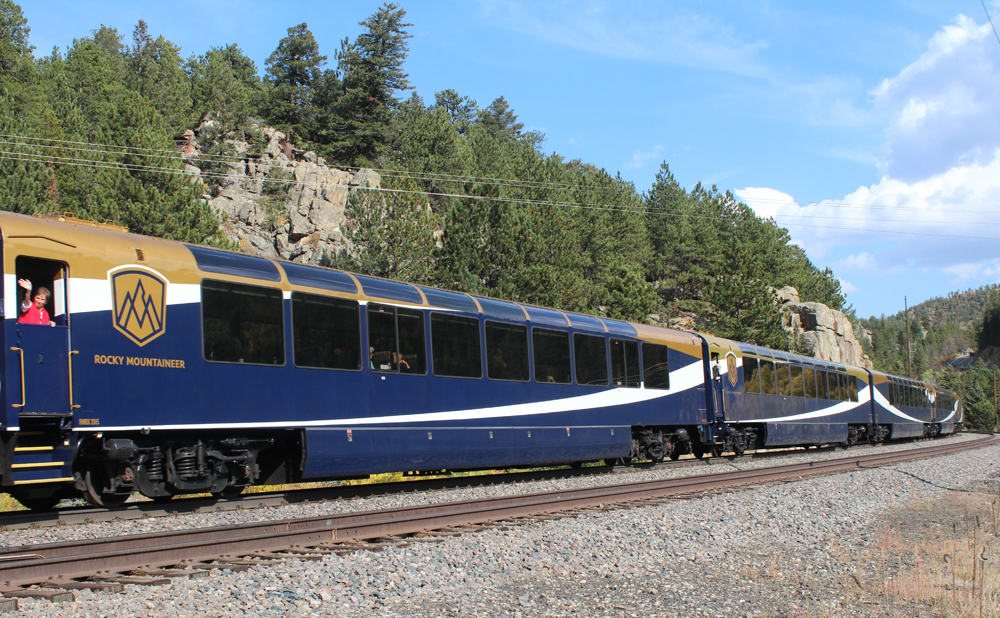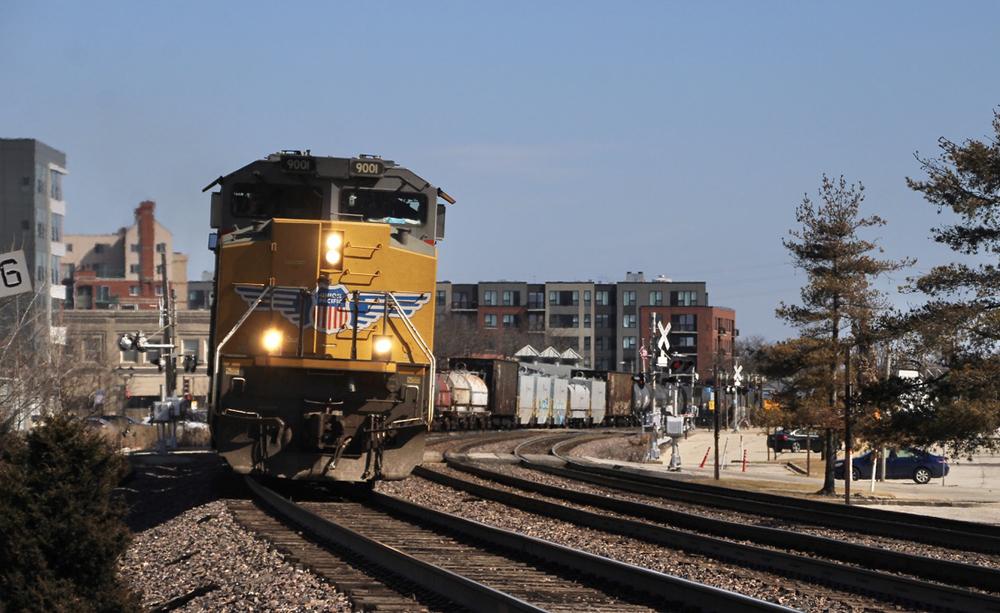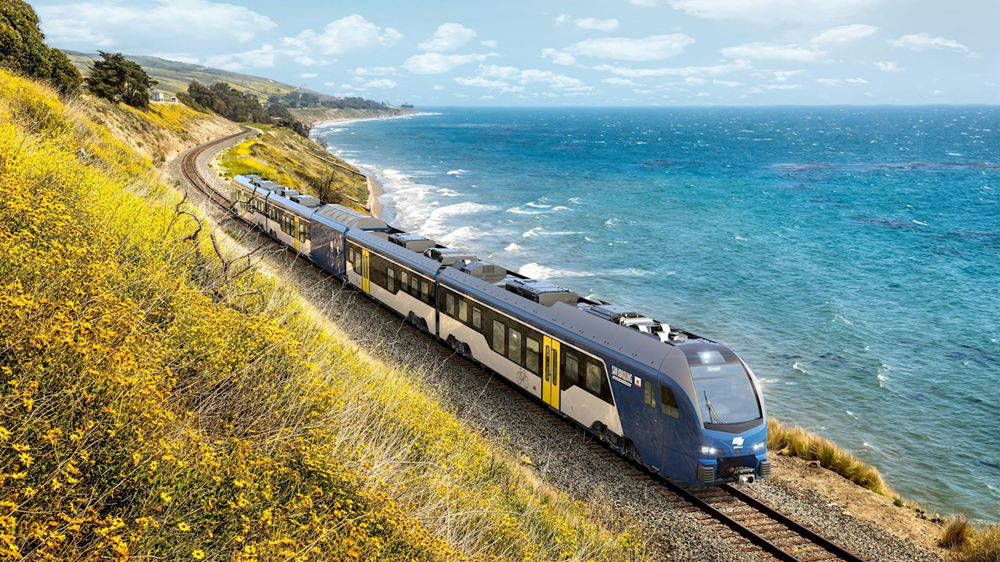Most railroads still weren’t ready to give up on passenger travel, and their eagerness to win back travelers gave way to some out-of-the-box ideas. One of those ideas was the General Motors Aerotrain.
General Motors’ designers had four goals: style (not luxury), comfort, light weight, and low operating cost.
The Aerotrain was clearly a product of novel thinking. Gone were 80-foot-long cars, replaced by 40-foot-long cars that were also nearly three feet shorter from the ground up to the roofline. A pair of the 40-foot cars weighed 32 tons, while one 80-foot-car weighed 65 tons. The Aerotrain offered the same passenger capacity in the same space with half the weight.
GM also designed the low-cost aluminum bodies to be replaced every seven years, which reduced railroad maintenance costs significantly.
The train was powered by the LWT-12, a lightweight 1,200-horsepower diesel engine. Just as today’s motorists keep an eye on the mileage, so did GM’s designers, and the LWT-12 used “just” 1.3 gallons per mile.
While innovative inside and out, the Aerotrain ultimately was less than successful. Those who liked train travel were under-whelmed by the pseudo bus decor of the passenger cars. There were teething problems causing mechanical woes, and the train was underpowered when fully loaded or traveling on rugged terrain. Most important – from the view of the paying public – the ride was very rough.
The two demonstrator trains were eventually sold to the Rock Island, where they bumped and bounced Chicagoland commuters until they were retired in 1966. Today one Aerotrain resides at the National Railway Museum in Green Bay, Wis., and the other is in the National Transportation Museum in St. Louis.
The model
From some camera angles the real Aerotrain looks sleek and stylish, and from others it looks equally sleek – but stubby. The MTH model captures both of these seemingly contradictory looks.
Although in the RailKing line, the diminutive Aerotrain is quite close to 1:48 scale. The shell of the powered unit is 13 inches long (52 feet in scale), the coaches are just over 91/4 inches long (37 feet in scale), and the observation car shell is 11 inches long (44 feet in scale). When coupled, there is a 1-inch gap between each car. MTH offers two sizes of rubber passenger car diaphragms with the train, a short set for tight-radius layouts and a longer set for wide-radius layouts.
The nose of the powered unit is as smooth as a Detroit show car, as is the gentle slope behind the locomotive cab (I’m almost tempted to call it a flight deck). There is a separate add-on piece that completes the downward incline toward the rear vents. Looking through the windshield you won’t find crew figures or any cab details, but a gray plastic shield hides the front can-style motor.
You’ll find plenty of cast-in vents, hatches, latches, and, where appropriate, rivet detail on the body shell of the locomotive. The rolling stock has a similarly pleasing level of detail that evokes the obvious city bus heritage of the prototype, down to the luggage bins (probably converted for battery storage) along the skirts.
On the prototype, the Aerotrain logo on the sides of the train is three-dimensional; on the model it is painted on. I found photographs of the Aerotrain with a rear coupler sticking out beneath the “license plate” on the observation car. MTH probably omitted this to keep the look of the tail-finned rear car smooth.
The cars feature interior seating and illumination. I thought that the seats looked too high in relation to the windows, but a close examination of prototype photographs and drawings suggests that they are in line.
Like a city bus, each car has a single axle at each end. The model features die-cast metal sideframes. There are also two power pickup rollers for interior lighting on each car spaced 51/2 inches apart.
Paint and decoration are simplicity in itself. The silver General Motors paint scheme was common to all the roads the locomotive tested on – the only difference being the railroad logo on the nose. The silver paint and red accents are skillfully applied, and the Aerotrain logo and New York Central name and emblem on the power unit are crisp.
On the test track
Since nearly all of the MTH locomotives we have tested in the past three years have included ProtoSound 2.0, we instead chose a LocoSound version of the Aerotrain to test.
RailKing LocoSound locomotives are less expensive than their ProtoSound 2.0 twins because they do not contain receivers to operate in command-control mode and they do not contain MTH’s best sound system. However, LocoSound locomotives do have MTH’s great “cruise control.”
The prototype Aerotrain locomotive had just three axles. At first look, so does this model. On second look, however, you’ll find that the rear powered truck has pilot or idler wheels leading the powered axle.
Our test performance numbers for the Aerotrain were very good. We measured low-end speed average at 3.1 scale mph and the high-end average at 66.8 scale mph. Drawbar pull was 1 pound, 10 ounces.
On the track our Aerotrain accelerated smoothly, but the four-wheel cars bounced through a few switches, which was one of the problems of the prototype. None of the cars derailed.
This set differs slightly from other recent RailKing streamliner sets like the M-10000 or the Zephyr. Those trains have two can-style motors, like the Aerotrain, but the second motor was part of the rear truck of the observation cars. It was connected to the front of the train through a series of tethers. The Aerotrain’s motors are both in the lead unit, so there are no tethers to connect.
The Aerotrain also differs from the other streamliners by using conventional, die-cast metal dummy couplers to mate the cars. The M-10000 (CTT, December 2001) and Zephyr (CTT, December 2000) cars, two of which share one truck, latch together sometimes awkwardly using slots and pins. With its traditional couplers, if whimsy strikes, you could add an REA express car to the Aerotrain or even pull a freight train with the locomotive.
Since I’ve seen at least one prototype photo with the powered unit towing a train of 10 cars, you’ll be glad to know that separate-sale coaches are available to expand the size of your train.
As with some other RailKing streamliners, the Aerotrain comes with short rubber diaphragms installed between cars and longer ones packaged in the box. If you are running on anything other than the tightest curves, you’ll want to install the longer rubber sections.
The diaphragms come out easily, but to install the second set you’ll find it easiest to nudge each diaphragm’s rubber prongs into the body shell holes using a small screwdriver.
While the generic LocoSound system leaves a lot to be desired, it isn’t without its charms. Though this sound package might not be pleasing in an F3, the Aerotrain’s almost eerie, pulsing thrum comes off as a pseudo sci-fi sound like that used in Lionel’s Phantom. In a weird way, it works with the futuristic appearance of the Aerotrain.
The MTH Aerotrain is unique by any standard. It is a safe bet that you probably don’t have many other trains on your pike with tail fins! It ran well and is, frankly, affordably priced.
So even if you mainly run heavy freights, this baby might be just what you need to keep your 1:48 scale citizens from taking the plane or the interstate instead.















Just purchased this train and the front forward facing center pickups get stuck in the center rail gap on O-31 realtrax switches. Had to remove the front pickups to run the train. Has anyone else had this problem? Now the car lights blink as they go over switches when they lose center rail contact.
I have one of these and it is a very nice set, although I'm not all that enamored with MTH products. I bought one additional car when I purchased the set. With the two motors this train will really fly . I mostly have this unit sitting on my display shelf, but occasionally I let it stretch it's legs on my 072 curves.
Nice review.